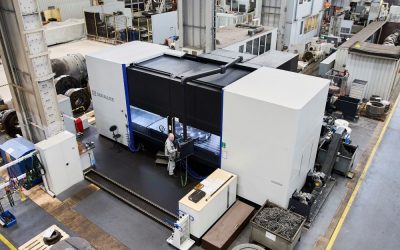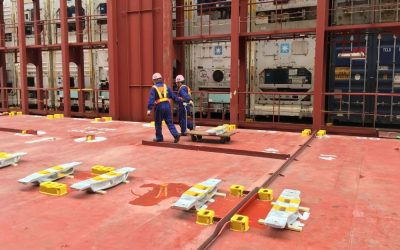Juha-Pekka Kivioja, global product manager for large motors and generators, ABB
Greater energy efficiency is essential to the future of shipping. With the total volume of goods transported by sea expected to triple by 2030, the status quo cannot continue. Today, shipping accounts for almost 3% of all greenhouse gas (GHG) emissions, according to the Organisation for Economic Cooperation and Development (OECD) – and these emissions would also triple if the sector doesn’t make changes.
There are new initiatives to encourage greater efficiency. At the beginning of this year, for example, the International Maritime Organization (IMO) launched the Energy Efficiency Existing Ship Index (EEXI). Vessels are also required to report their annual Carbon Intensity Indicator (CII) rating.
A straightforward way to improve a vessel’s energy efficiency is through the selection of the right generator technology. It is understood that generating electrical power from a vessel’s main propulsion engine is more efficient than using auxiliary gensets. This is achieved by mounting a generator directly onto the vessel’s propulsion shaft.
Traditionally, shaft generators have used rotor winding arrangements. However, solutions that use permanent magnets (PMs) are smaller, lighter, simpler to install and – most importantly – more efficient. This makes them an appealing option for shipbuilders and those looking to retrofit existing vessels, as well as operators, who benefit from fuel savings and more straightforward maintenance.
Smaller, lighter and more efficient
With vessel emissions under increasing scrutiny, every possible reduction matters. Switching from a coil winding shaft generator to a PM solution immediately cuts fuel use by approximately 3-4%. Even greater savings are possible by optimising the engine’s operations, with the potential to cut fuel use by 10% at partial load.
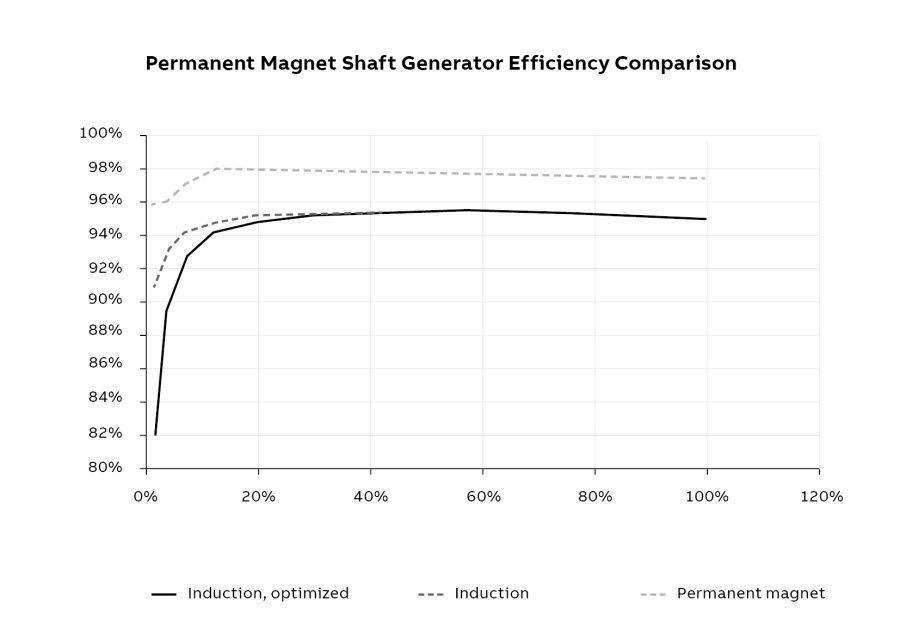
Permanent magnet generators are more efficient than induction generators at all power levels
In addition to greatly improving the generator’s efficiency, PM solutions offer a range of other benefits compared with induction solutions. For example, permanent magnet shaft generators (PMSGs) achieve a greater power-to-weight ratio. They require 20% less space than an equivalent induction or electrically excited synchronous generator, and are as much as 30% lighter.
PMSGs are also simpler to service, as the winding-free rotor has fewer components. The fact that the design doesn’t require carbon brushes removes one of the most common maintenance requirements. Their robustness has led to PMSGs gaining popularity in demanding applications such as offshore wind. Manufacturers are also designing modern PMSGs as plug-and-play systems, further simplifying their installation in both new and existing vessels.
The use of an efficient PMSG eliminates the need for auxiliary gensets, resulting in significant capital expense (CapEx) savings. The increased efficiency, meanwhile, results in lower fuel costs, contributing to ongoing operational expense (OpEx) savings.
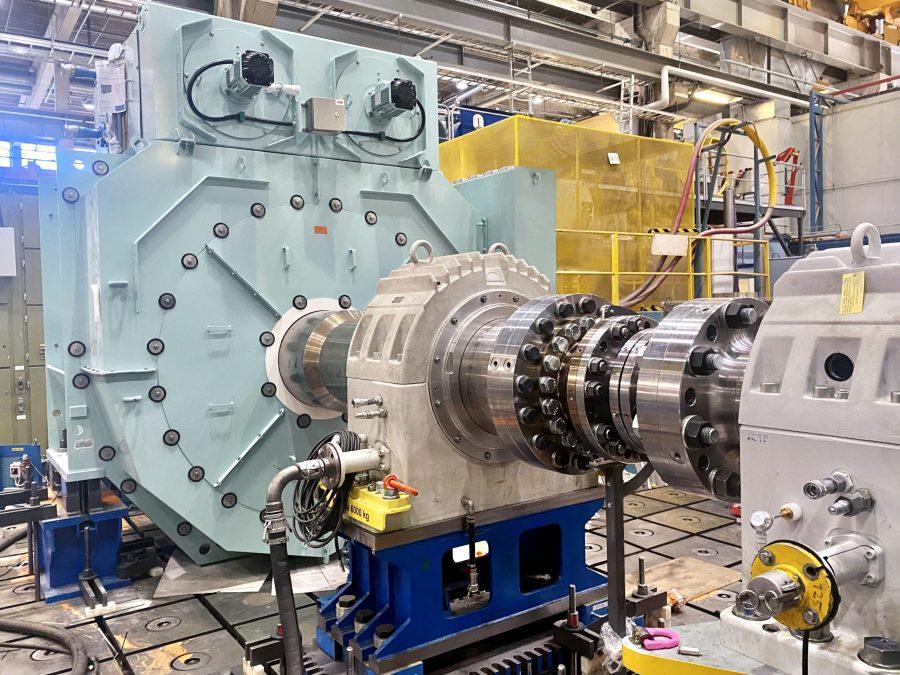
Source: ABB
Enabling flexibility with variable speed drives
Traditionally, the only way shaft generators have been able to deliver a fixed frequency to the vessel’s electrical network is by running the main engine at a constant speed. This is an inefficient approach at partial loads, which is where vessels spend a significant portion of their operating time. The reason is that the propeller and engine are both less efficient when operating at high rpm and low loads.
To overcome this limitation, the shaft generator can be fitted with a variable speed drive (VSD). A VSD enables the generator to operate at any shaft speed, so the vessel can always use the most efficient combination of speed and propeller pitch. Running the system at the ideal operating point enables fuel savings of as much as 40% over fixed or direct-on-line running. This also results in lower CO2 and nitrogen oxide (NOx) emissions.
When specifying a PMSG for this use case, operators must be sure to select an option that is designed for operating at low speeds. These solutions are engineered to account for minor magnetisation losses, ensuring that they maintain high efficiency at low speeds and partial loads.
PMSGS are suitable for various operating modes
Permanent magnet shaft generators are available that work efficiently across all three standard operating modes:
- Power Take Off (PTO), where the generator uses the main motor to produce power.
- Power Take In (PTI), for peak power in challenging circumstances such as heavy weather.
- Power Take Home (PTH), which is used for redundancy and in emergencies). Vessels designed with PTH capability often use battery power to operate in an all-electric mode while in ports or zones with emission or noise limits.
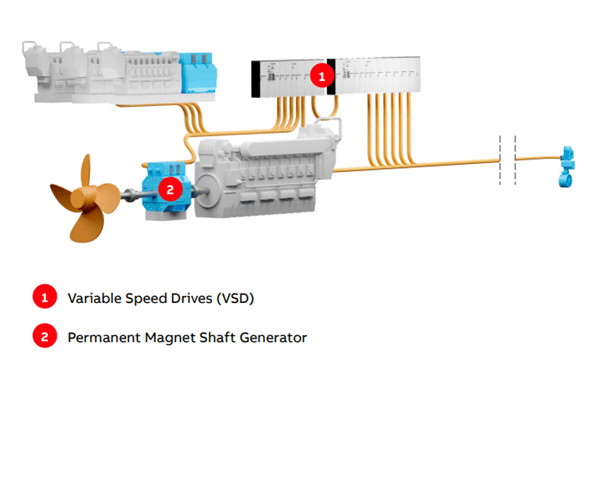
Cap: The main elements of a permanent magnet shaft generator system
Permanent magnet technology in action
Bermuda-based operator Himalaya Shipping is aiming to increase the efficiency of its 12 dual-fuelled bulk carriers with 210,000dwt and identified PMSGs as a solution. The operator has selected the latest generation PMSG, ABB’s AMZ 1400, which includes ABB ACS880 VSDs that enable consistent operation across a range of speeds, weights and loads.
The generators include a built-in water jacket and heat exchanger. This enables optimal cooling and further reduces the size needed to deliver the required power. Since the vessels operate in a tropical climate, this also makes the working environment cooler and more pleasant for crew and reduces the need for ventilation and air conditioning.
Selecting permanent magnet shaft generators just makes sense
PMSGs are significantly more efficient than the common rotor winding design. Because of this, motors can operate at a lower speed to achieve the same power output, resulting in fuel savings. This enables operators to improve their CII rating.
PMSGs are also smaller and lighter, making them easier to work with, and modern models are designed to be plug-and-play, further streamlining the installation process. The lower number of components and other design features also make PMSGs far more robust and – when required – far easier to maintain.
The various advantages of PMSGs over existing rotor winding solutions make a clear case for shipbuilders and operators, whether they are commissioning new vessels or upgrading existing ones. PM solutions bring us one step closer to achieving the International Maritime Organisation’s target of halving GHG emissions from shipping by 2050.

